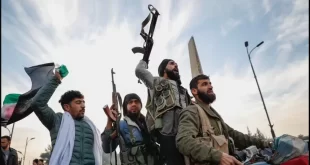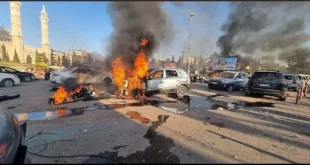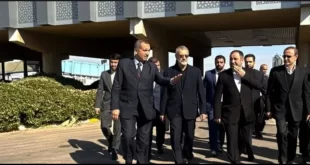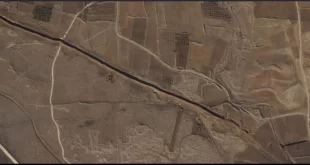Oct 15, 2013, James M. Wall
This week’s Geneva nuclear table talks pit Iran against the Big Five Security Council members, plus Germany.
Iran sits alone at the table, seeking release from its “sanctions jail” incarceration from its jailers, the Big Five plus one nations.
Israel will not be in the room, even though the region’s self-proclaimed “only democracy”, is Iran’s chief accuser in these talks.
Israel’s leaders will be back home, hiding behind what Israel calls its “ambiguity wall”, a metaphorical entity which hides at least 80 Israeli nuclear war heads, plus the material to build hundreds more.
The ambiguity wall has protected Israel’s growing nuclear arsenal from the world’s eyes since the 1950s. In 1986, Mordechai Vanunu, an Israeli nuclear technician working in Dimona, breached the wall when he leaked the country’s nuclear secrets to a British newspaper.
Vanunu said Israel had at least 100 nuclear weapons. He was kidnapped by Israeli Mossad agents in Rome and quickly convicted of espionage and treason. He served a jail term of 18 years, 11 of which were in solitary confinement.
After his release in 2004, Vanunu was forbidden to leave the state of Israel or speak with journalists. Born in Marrakech, Morocco, to a Sephardi rabbi, Vanunu learned the hard way that it is not nice to talk about what goes on behind Israel’s “ambiguity wall”.
The wall continues to be accepted as “ambigious” by world media and governments, thanks to the powerful influence of the United States, Israel’s big brother protector and financial sugar daddy. Thanks to big brother, the talks in Geneva are proceeding as though Iran’s major accuser is not needed in the nuclear table talks.
Iran, sitting as the “accused” in Geneva, does not put its nuclear facilities behind an “ambiguity” wall. The BBC offers a close look at Iran’s various nuclear production sites. This report relies on Iran’s open stance regarding its program, in contrast to Israel’s lack of transparency.
Iran resumed uranium enrichment work at Natanz in July 2004, after a halt during negotiations with leading European powers over its program.
It announced in September 2007 that it had installed 3,000 centrifuges, the machines that do the enrichment. In 2010, Iran told the IAEA Natanz would be the venue for new enrichment facilities – construction of which would start around March 2011.
This is the facility at the heart of Iran’s dispute with the United Nations Security Council.
The Council is concerned because the technology used for producing fuel for nuclear power can be used to enrich the uranium to a much higher level to produce a nuclear explosion.
Of course fuel produced for nuclear power can be used to produce a nuclear explosion. There is no secret about this reality. Iran wants what every developed nation wants, a developed nuclear power system, and the option to build stronger, more lethal, stuff.
Were it not for a desire to compete for military power among nations like the Big Five, plus Germany, all of whom are well armed with nuclear weapons, the world would have moved decades ago to eliminate all nuclear weapons.
They have not, so we are left with the larger powers working hard to limit nuclear arms to those who have already crossed into nuclear arms territory. Once into that territory, nations are asked to sign the Nuclear Non-Proliferation Treaty. Israel, of course, has never signed the treaty, nor has it been pressured to do so.
Meanwhile, in Geneva, The Guardian reports the not-yet-public opening proposal from Iran to the peace talks:
The Iranian delegation to international talks in Geneva has presented proposals which it claims will end the longstanding deadlock over its nuclear program.
Iran’s foreign minister, Mohammad Javad Zarif, gave an hour-long PowerPoint presentation of the proposals, entitled “Closing an unnecessary crisis: Opening new horizons”, to senior diplomats from the US, UK, France, Germany, Russia, and China at the Palace of Nations in Geneva on Tuesday.
The presentation was not made public, but it is believed to lay out a timetable for a confidence-building deal that would place limits on Iran’s nuclear program in return for relief from sanctions and international recognition of the country’s right to enrich uranium.
A recent story in the Los Angeles Times, published September 15, 2013, demonstrated that Israel’s media protection had begun to slip.
Israel has 80 nuclear warheads and the potential to double that number, according to a new report by U.S. experts.
In the Global Nuclear Weapons Inventories, recently published in the Bulletin of the Atomic Scientists, proliferation experts Hans M. Kristensen and Robert S. Norris write that Israel stopped production of nuclear warheads in 2004.
But the country has enough fissile material for an additional 115 to 190 warheads, according to the report, meaning it could as much as double its arsenal.
Previous estimates have been higher but the new figures agree with the 2013 Stockholm International Peace Research Institute yearbook on armament and international security. The yearbook estimated 50 of Israel’s nuclear warheads were for medium-range ballistic missiles and 30 were for for bombs carried by aircraft, according to a report in the Guardian.
The Times story included the usual boiler plate caveat required in covering Israel’s nuclear arsenal.
Although widely assumed a nuclear power, Israel has never acknowledged possessing nuclear weapons or capabilities and continues to maintain its decades-old “strategic ambiguity” policy on the matter, neither confirming nor denying foreign reports on the issue.
Foreign Policy carried a report September 9, that on the chemical weapons front, Israel does not have clean hands.
Syria’s reported use of chemical weapons is threatening to turn the civil war there into a wider conflict. But the Bashar al-Assad government may not be the only one in the region with a nerve gas stockpile. A newly discovered CIA document indicates that Israel likely built up a chemical arsenal of its own.
It is almost universally believed in intelligence circles here in Washington, that Israel possesses a stockpile of several hundred fission nuclear weapons, and perhaps even some high-yield thermonuclear weapons. Analysts believe the Israeli government built the nuclear stockpile in the 1960s and 1970s as a hedge against the remote possibility that the armies of its Arab neighbors could someday overwhelm the Israeli military. But nuclear weapons are not the only weapon of mass destruction that Israel has constructed.
Reports have circulated in arms control circles for almost 20 years that Israel secretly manufactured a stockpile of chemical and biological weapons to complement its nuclear arsenal. Much of the attention has been focused on the research and development work being conducted at the Israeli government’s secretive Israel Institute for Biological Research at Ness Ziona, located 20 kilometers south of Tel Aviv.
But little, if any, hard evidence has ever been published to indicate that Israel possesses a stockpile of chemical or biological weapons. This secret 1983 CIA intelligence estimate may be the strongest indication yet.
According to the document, American spy satellites uncovered in 1982 “a probable CW [chemical weapon] nerve agent production facility and a storage facility… at the Dimona Sensitive Storage Area in the Negev Desert. Other CW production is believed to exist within a well-developed Israeli chemical industry.”
Meanwhile, as the Geneva talks proceed, President Obama appears to be ready for the U.S. and Iran to work toward more cordial relations. That telephone call the President shared with Iranian President Hassan Rouhani has begun to pay dividends.
This has not been well received in Saudi Arabia, one of the few remaining Middle Eastern countries still friendly with Israel. Iran’s Fars News Agency reported the Saudis response to the improved Washington-Teheran relationship:
Saudi officials have reportedly become deeply upset and anxious over the Iranians’ success during President Hassan Rouhani’s recent visit to New York and the possible start of rapprochement between Tehran and Washington, and are seeking a way to sabotage the trend, a source said.
“The Saudi officials are highly distressed over this rapprochement and have held a meeting on September 24 in the presence of President of the Royal Court Khalid al-Tuwaijri, Commander of the National Guard Mutaib bin Abdullah, Interior Minister Prince Mohammed bin Nayef and National Security Council Secretary and Intelligence Chief Prince Bandar Bin Sultan,” an informed source close to the Saudi Royal family told FNA on Sunday.“At the meeting the relations between Iran and the US and the settlement of Iran’s nuclear issue with the Group 5+1 (the five permanent UN Security Council members plus Germany) came under study and Iran’s growing chances of success on this path were assessed to be much dangerous to Saudi Arabia’s national security,” the source added.
The source said that the Saudi officials have decided to use all their diplomatic and intelligence capabilities and possibilities as well as their lobbies in the US to blockade a rapprochement between Tehran and Washington and Bandar bin Sultan was assigned to study possible ways of stirring tension between Iran and the US.
“The meeting also decided that any plan developed in this regard should be coordinated with the Israeli lobbies, which are also angry at the positive atmosphere created between Iran and the US,” the source concluded.
The times they really “are a-changin’” when Israel’s U.S. lobby forces are forced to make common cause with those of Saudi Arabia.
 Syria Support Movement solidarity with the Syrian people
Syria Support Movement solidarity with the Syrian people




